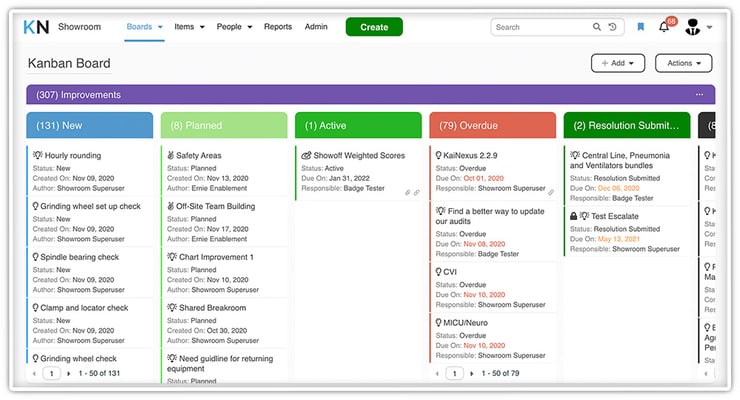 Agile project management is an iterative philosophy that focuses on delivering value frequently and getting quick feedback from internal and external customers to adapt to emerging changes quickly. It is based on:
Agile project management is an iterative philosophy that focuses on delivering value frequently and getting quick feedback from internal and external customers to adapt to emerging changes quickly. It is based on:
- Limiting work in progress to small batches
- Using visual management to create transparency
- Working in close collaboration with the customer
- Get feedback as quickly as possible.
This approach allows organizations to promptly adapt to changing customer requirements and produce higher-value products or services to better satisfy their customer's needs.
Rather than being a prescription for how projects should be managed, Agile is a way of thinking that allows people to approach problem-solving collaboratively and deliver more value faster.
A Brief History of the Agile Approach
The agile approach started in the software development industry with what is often called "the application development crisis in the early 1990s. In those days, there was often a significant amount of lag time, sometimes as long as three years, between identifying a business need for a software application and the actual delivery of the product. Frequently, by the time the product was in the hands of the customer, new technology had changed the landscape, or the customers' needs had changed. The result was many failed projects and lost of wasted money.
Frustrated by the situation, software developers started organizing informal meetings to find a method to develop products more easily and rapidly. What emerged from one such meeting in February 2001 was the "Agile Manifesto." It has influenced how projects are managed in software companies and many others with a similar need to deliver customer value with haste.
What is Agile Project Management?
The word "agility" means "mobility nimbleness," incorporating the Latin "agere" or "to do, to act." The root is the ability to move forward quickly and allow for quick direction changes.
There are five building blocks of the Agile method. Together, they are what constitutes an agile project.
Transparency
Agile relies on all stakeholders' shared understanding of the process, including the definition of success. This requires a high level of transparency, teamwork, and communication.
In an Agile organization, people communicate their work progress by leveraging visual management tools such as Kanban boards. When work-in-progress is visualized, everyone understands what their peers are working on. As a result, backlogs become apparent, and resources waiting for inputs are minimized.
In addition, team members openly share their ideas and struggles without fear of backlash. Agile leaders believe it is better to communicate, own mistakes, and work together toward the desired outcome.
Customer Focus
The Agile way of thinking about project management puts customer requirements at the forefront of every project. Therefore, agile requires a deep understanding of the customer requirements and specifications. In addition to delivering what the customer asks for, Agile teams deliver value that solves problems.
Frequent feedback is a necessary element of Agile project delivery. It allows customers to check in to see if what is being provided actually fits their needs. In addition, each feedback checkpoint contributes to a better understanding of the underlying needs.
Frequent customer collaboration increases the efficiency of projects because it eliminates extensive project rework that occurs if the customer's voice is lost in translation. Therefore, Agile projects have lower costs, delivering more value to the customer.
Adaptability
Along with customer focus, a central idea of Agile project management is that teams must be responsive to changes that result from customer feedback. Therefore, Agile teams iterate and break projects down into smaller chunks rather than producing one big piece of work.
Work-in-progress is synchronized with the customer and the Agile project lifecycle. This approach lets teams capture any changing customer needs early in the project. They can then quickly adapt to the new reality and avoid significant delays in delivering the final project.
The objective is to ensure that what is being created is synchronized with the end-user and the Agile project lifecycle. As a result, teams will capture changing customer requirements early in the process, quickly adapt to the new situation, and avoid significant delays in the final project delivery.
Sense of Ownership
To achieve the goals of Agile management, there must be a sense of ownership within the team and a desire for collaborative leadership. Therefore, rather than being controlled by a project manager who assigns tasks to team members, much of the decision-making is done by team members in Agile projects.
The idea is that the people closest to the technical elements of the work are best positioned to decide how to execute tasks. Team members collaborate and engage in problem-solving based on their expertise instead of waiting for instructions from higher up.
Continuous Improvement
The final common attribute of Agile is the search for continuous improvement. Agile teams frequently engage in learning cycles rather than waiting for one "lessons learned" report at the end of the project. This approach means that process improvements can happen while the Agile project is still in progress.
Not only does frequent feedback from customers ensure that the deliverable is constantly improved, feedback from team members means that the way of working gets better incrementally over time.
Agile Project Management Phrases
While each organization and project is different, Agile projects often utilize the following phase structure.
Envision: Team members craft the high-level deliverable vision for the customer and determine who will be involved in the project.
Speculate: Next, the team gathers the broad initial requirements for the project and develops an interaction plan based on the goal.
Explore: The team begins to work on the project tasks, focusing on uninterrupted flow and getting feedback from the customer as quickly as possible.
Adapt: Based on that feedback, the team review result and adapts to any new information.
Close: Once the project is complete, key findings are documented and passed along to increase tribal knowledge.
Agile Project Management Techniques
Because highly prescriptive project management frameworks with massive Gantt charts are the opposite of agile, many organizations instead introduce techniques that help achieve a stable workflow and tailor each project to the present needs.
The most commonly used Agile project management techniques are Kanban and Scrum. When they are used together, which they frequently are, it is called Scrumban.
Kanban
Kanban is a work-in-progress management technique that has six fundamental principles:
-
- Visualize work
- Limit the amount of work-in-progress
- Manage flow
- Make process policies explicit
- Leverage feedback loops
- Improve through collaboration
The primary visualization method is a Kanban board. It becomes the central information hub where all tasks are assigned and managed. The board is divided into columns that indicate stages of the workflow. Some teams use physical Kanban boards, but these days, Kanban software improves access and increases the value of Kanban.

Scrum
Scrum is an iterative technique that uses timed intervals called sprints. The project is broken down into small pieces that are delivered on a regular cadence.
Scrum consists of three roles:
The Product Owner: The product owner represents customers and other stakeholders. They organize and control the product backlog.
The Scrum Master: The Scrum Master is a leader within the team that focuses on leadership and helping everyone apply the project policies.
The Team: Everyone else is a member of the team.
There are four major Scrum events:
-
- Sprint Planning
- Daily Scrum
- Sprint Review
- Sprint Retrospective
While not ideal for every type of project, the Agile approach is gaining popularity even outside the software development industry because it results in outputs that meet customer needs faster and with higher quality results.
To learn more, we recommend the Project Management Institute's, Agile Practice Guide.


Add a Comment